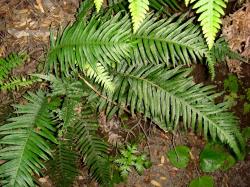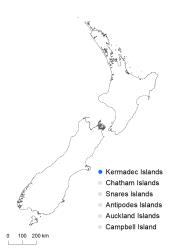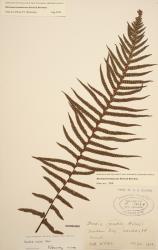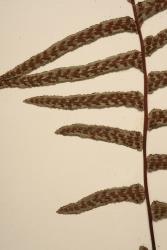- ≡ Doodia milnei Carruth. in Seemann, Fl. Viti. 352 (1873)
- ≡ Doodia media var. milnei (Carruth.) Baker, Syn. Fil., ed. 2. 482 (1874)
- ≡ Doodia caudata var. milnei (Carruth.) Domin, Biblioth. Bot. 20(85): 126 (1913)
Rhizomes erect, to 130 mm long (in herbarium material), bearing scales. Rhizome scales narrowly ovate, 5–7.5 mm long, 1–1.5 mm wide, black-brown, concolorous. Fronds monomorphic, arching outwards, 310–770 mm long. Stipes 100–300 mm long, black-brown proximally, becoming red-brown distally, bearing black-brown narrowly ovate scales, sparsely hairy or glabrous. Rachises red- or yellow-brown, grooved adaxially, bearing scales, sparsely hairy or glabrous. Laminae 270–540 mm long, 92–245 mm wide, pinnatisect to 1-pinnate, elliptic to narrowly elliptic, tapering to a short, pinnatifid apex, similar colour on both surfaces, never tinged red when young, coriaceous, sparingly hairy or glabrous, bearing occasional scales on costae, lacking tubercles. Pinnae in 17–35 pairs, closely to widely spaced, narrowly oblong, straight, becoming flabellate at the base of the lamina; the longest pinnae at about the middle, 44–140 mm long, 3–15 mm wide; apices acuminate or acute, margins sharply serrate, bases decurrent on distal pinnae, stalked or sessile on proximal pinnae; the basal pinnae opposite; the terminal pinna 55–120 mm long, usually <⅛ of total frond length. Veins anastomosing. Sori elongated, discrete, in 1–2 rows either side of midvein; indusia narrowly oblong, 2–3 mm long, opening towards the midvein, glabrous.
Blechnum kermadecense, previously included in the genus Doodia, is recognised by its monomorphic fronds, anastomosing veins, and discrete rather than continuous sori arranged in two rows parallel to the pinna costae. It is distinguished from B. molle and B. zeelandicum by its pinnae, which are mostly adnate, and stalked only in the lower third of the rachis. It is most similar to B. parrisiae, which also occurs on the Kermadec Islands. Blechnum kermadecense has generally longer and more membranous pinnae (44–140 mm long, cf. 5–80mm long), is glabrous or only sparsely hairy on the rachises and laminae, and has young fronds that are never tinged pink. It is also said to have fronds of pale grassy-green colour (Parris 1972).
Kermadec Islands.
Altitudinal range: 90–300 m.
Blechnum kermadecense is endemic to the Kermadec Islands, where it has been recorded from Raoul Island (Sykes 1977) and Macauley Island (de Lange 2015).
Blechnum kermadecense is a terrestrial fern, occurring in dry Metrosideros kermadecensis forest, in clearings, on tracksides, on banks, among scoria and boulders, and in more open areas. It is rare in the wetter forest.
Blechnum kermadecense was given a conservation status of At Risk/Naturally Uncommon by de Lange et al. (2018).
2n = c. 160 (de Lange et al. 2004).
This species was misidentified as Doodia connexa Kunze in some earlier New Zealand Floras. It was recognised as Doodia media var. milnei by Allan (1961), but raised to species rank by Parris (1972). When treated in Blechnum it requires the new name, B. kermadecense (Perrie et al. 2014).







